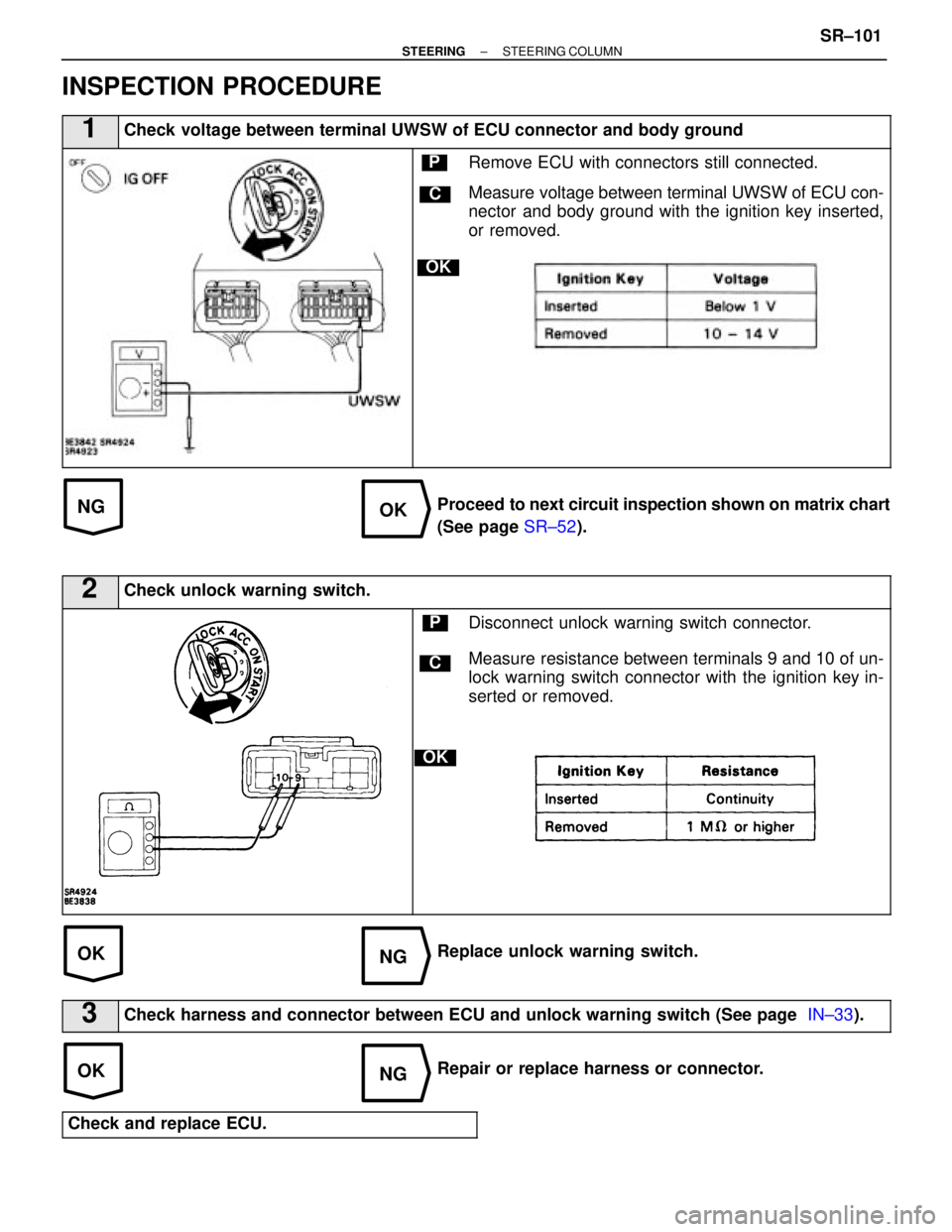LEXUS SC400 1991 Service Repair Manual
Manufacturer: LEXUS, Model Year: 1991, Model line: SC400, Model: LEXUS SC400 1991Pages: 4087, PDF Size: 75.75 MB
Page 2961 of 4087

NGOK
OKNG
OKNG
INSPECTION PROCEDURE
1Check voltage between terminal UWSW of ECU connector and body ground
C
OK
PRemove ECU with connectors still connected.
Measure voltage between terminal UWSW of ECU con-
nector and body ground with the ignition key inserted,
or removed.
Proceed to next circuit inspection shown on matrix chart
(See page SR±52).
2Check unlock warning switch.
C
OK
PDisconnect unlock warning switch connector.
Measure resistance between terminals 9 and 10 of un-
lock warning switch connector with the ignition key in-
serted or removed.
Replace unlock warning switch.
3Check harness and connector between ECU and unlock warning switch (See \
page IN±33).
Repair or replace harness or connector.
Check and replace ECU.
±
STEERING STEERING COLUMNSR±101
WhereEverybodyKnowsYourName
Page 2962 of 4087

POWER STEERING
DESCRIPTION
SR0KG±03
The Progressive Power Steering (PPS) is basically a power rack and pinion\
gear with a rotary control valve.
The PPS varies the amount of hydraulic assistance with respect to vehicle r\
oad speed. In addition the unit
incorporates an electronically controlled hydraulic reaction chamber.
PRINCIPLES OF POWER STEERING
Power steering is a hydraulic device which utilizes engine power to reduce ste\
ering effort. Consequently,
the engine is used to drive a pump to develop fluid pressure, and this p\
ressure acts on a piston within the
power cylinder so that the piston assists the rack effort. The amount of this assistance depends on the ex-
tent of pressure acting on the piston. Therefore, if more steering force is \
required, the pressure must be
raised. The variation in the fluid pressure is accomplished by a control valve \
which is linked to the steering
main shaft.
SR±102
±
STEERING POWER STEERING
WhereEverybodyKnowsYourName
Page 2963 of 4087

OPERATION
NEUTRAL (STRAIGHT±AHEAD) POSITION
SR0NU±01
Fluid from the pump is sent to the control valve. If the control valve is in \
the neutral position, all the fluid
will flow through the control valve into the relief port and back to the pu\
mp. At this time, hardly any pressure
is created and because the pressure on the cylinder piston is equal on bot\
h sides, the piston will not move
in either direction.
WHEN TURNING
When the steering main shaft is turned in either direction, the control valv\
e also moves, closing one of the
fluid passages. The other passage then opens wider, causing a change in fluid flow volume and, at the
same time, a differential pressure is created between both sides of the piston. Conseque\
ntly, the piston
moves in the direction of the lower pressure so that the fluid in the cylinder is forced back to the pump
through the control valve.
±
STEERING POWER STEERINGSR±103
WhereEverybodyKnowsYourName
Page 2964 of 4087

SERVICE HINT
Troubles with the power steering system are usually concerned with hard steering due to the fact that there
is no assistance. In such cases, before attempting to make repairs, it i\
s necessary to determine whether
the trouble lies with the pump or with the gear housing. To do this, an on±vehicle inspection, can be made
by using a pressure gauge.
ON±VEHICLE INSPECTION Power steering is a hydraulic device and problems are normally due to insufficient fluid pressure acting on
the piston. This could be caused by either the pump not producing the speci\
fied fluid pressure or the control
valve in the gear housing not functioning properly so that the proper fluid p\
ressure can not be obtained.
If the fault lies with the pump, the same symptoms will generally occur wh\
ether the steering wheel is turned
fully to the right or left. On the other hand, if the fault lies with the con\
trol valve, there will generally be a
difference between the amount of assistance when the steering wheel is turned to th\
e left and right, causing
harder steering. However, if the piston seal of the power cylinder is worn, there will be a loss of f\
luid pressure
whether the steering wheel is turned to the right or left and the symptoms will\
be the same for both.
Before performing an on±vehicle inspection, a check must first be made to c\
onfirm that the power steering
system is completely free of any air. If there is any air in the system, the volume of this air will change \
when
the fluid pressure is raised, causing a fluctuation in the fluid pressure s\
o that the power steering will not
function properly. To determine if there is any air in the system, check to see if there is \
a change of fluid
level in the reservoir tank when the steering wheel is turned fully to t\
he right or left.
For example, if there is air in the system, it will be compressed to a smal\
ler volume when the steering wheel
is turned, causing a considerable drop in the fluid level. If the system is free of air, there will be very little
change in the level even when the fluid pressure is raised. This is beca\
use the fluid, being a liquid, does
not change volume when compressed. The little change in the fluid level is d\
ue to expansion of the hoses
between the pump and gear housing when pressure rises. Also, air in the system will sometimes result in
an abnormal noise occurring from the pump or gear housing when the steerin\
g wheel is fully turned in either
direction.
This on±vehicle inspection must be performed every time to ensure tha\
t the power steering system is work-
ing properly after overhauling or repairing the pump or gear housing.
SR±104±
STEERING POWER STEERING
WhereEverybodyKnowsYourName
Page 2965 of 4087

VANE PUMPThe main component parts of the vane pump, such as the cam ring, rotor, vanes and flow control valve
are high precision parts and must be handled carefully. Also, because this pump produces a very high fluid
pressure, O±rings are used for sealing each part. When reassembling t\
he pump, always use new O±rings.
In the flow control valve, there is a relief valve which controls the maximum pressu\
re of the pump. The
amount of this maximum pressure is very important; if it is too low, there will be insufficient power steering
assistance and if too high, it will have an adverse effect on the pressure hoses, oil seals, etc. If the maximum
pressure is either too high or too low due to a faulty relief valve, do \
not disassemble or adjust the relief valve,
but replace the flow control valve as an assembly.
The clearance between the flow control valve and pump body installation hol\
e is very important. After
manufacture, the factory measures the size of the installation hole and outer circumf\
erence of the flow con-
trol valve, and punches a mark accordingly. Therefore, when replacing the flow control valve, be sure to
do so with one having the same mark in order to ensure the proper cleara\
nce.
The functional parts of the pump which produce fluid pressure are the cam r\
ing, rotor and vanes, and these
should be checked for wear. If the clearance between each is not within standard when reassembling\
, any
worn parts should be replaced.
In this case, the replaced cam ring and rotor should be of the same length\
(have the same mark), and the
vanes should be replaced with those having a length corresponding to that mark, other\
wise the proper
thrust clearance cannot be obtained. If there is too much thrust clearance, there will be insufficient fluid
pressure at low speeds. If there is too little thrust clearance, it may \
result in seizure of the vanes.
±
STEERING POWER STEERINGSR±105
WhereEverybodyKnowsYourName
Page 2966 of 4087

GEAR HOUSING
If the gear housing is secured directly in a vise during overhaul, there i\
s danger of deforming it, so always
first secure it in the SST provided (rack & pinion steering rack housing stand) before placing it in the vise.
The oil seals on both sides of the power cylinder are for the prevention of\
leakage of the high pressure fluid
which acts on the piston. Always use new oil seals when reassembling and be v\
ery careful not to scratch
or damage them.
Because of the high pressure, even the slightest scratch will cause fluid leakage, \
resulting in an inoperative
power steering system.
Also, be very careful not to scratch the sliding portion of the rack which ma\
kes contact with the oil seals.
When removing the rack ends from the rack, it is very easy to cause a burr w\
hen holding the tip of the rack
with a wrench. Therefore, before assembling the rack, first check the tip fo\
r burrs and remove any with an
oil stone.
Teflon rings are used for the piston and control valve. These teflon rings are highly durable against wear,
but if it is necessary to replace them, be careful not to stretch the new o\
nes.
After installing a teflon ring into its groove, snug it down into the gr\
oove before assembly of the cylinder
or housing to prevent possible damage.
SR±106
±
STEERING POWER STEERING
WhereEverybodyKnowsYourName
Page 2967 of 4087

As with the rack and pinion type steering, preload is very important. If t\
he preload is not correct, it could
result in such trouble as steering wheel play or shimmy or lack of durab\
ility, so always make sure that it
is correct.
±
STEERING POWER STEERINGSR±107
WhereEverybodyKnowsYourName
Page 2968 of 4087

IDLE±UP DEVICE
The pump produces the maximum fluid pressure when the steering wheel is tur\
ned fully to the right or left
and, at this time, there is a maximum load on the pump which causes a decrea\
se in engine idle rpm. To
solve this problem, vehicles are equipped with an idle±up device which acts to raise the engine idle rpm
whenever there is a heavy load on the pump.
On EFI engines, when the piston of the air control valve is pushed by fl\
uid pressure, the air valve opens
and the volume of air by±passing the throttle valve is increased to r\
egulate engine rpm.
The idle±up device functions to raise engine idle rpm when pump fluid pr\
essure acts on the air control valve,
installed to the pump body, to control the flow of air.
SR±108
±
STEERING POWER STEERING
WhereEverybodyKnowsYourName
Page 2969 of 4087

PREPARATION
SST (SPECIAL SERVICE TOOLS)
SR0FV±05
±
STEERING POWER STEERINGSR±109
WhereEverybodyKnowsYourName
Page 2970 of 4087

SR±110±
STEERING POWER STEERING
WhereEverybodyKnowsYourName